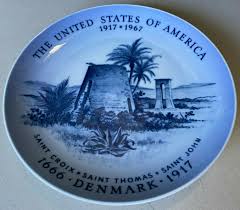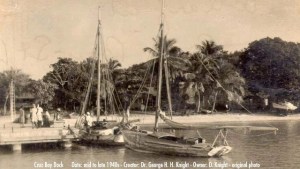The Acquisition of U.S. Virgin Islands: Strategic and Economic Implications
The acquisition of the U.S. Virgin Islands by the United States from Denmark in 1917 was a significant event in the history of both nations and the Caribbean region. This transaction, which involved the islands of St. Thomas, St. John, and St. Croix, was driven by strategic and economic considerations.

A commemorative plate from transfer day
During the early 20th century, the United States sought to expand its influence and secure its interests in the Caribbean. The Panama Canal, which opened in 1914, was a crucial strategic asset for the United States, connecting the Atlantic and Pacific Oceans. To protect this vital waterway, the U.S. government recognized the need for a strong naval presence in the Caribbean region.
Denmark, the colonial power ruling over the Danish West Indies, faced economic challenges in administering the islands effectively. The Danish government had difficulty managing the islands’ finances and maintaining necessary infrastructure developments. This situation presented an opportunity for the United States to negotiate the purchase of the Danish West Indies, which eventually led to the transfer of sovereignty.
The negotiations for the acquisition began in 1902 but faced several obstacles before reaching a final agreement in 1917. The United States initially expressed interest in purchasing the islands in 1867 and again in 1902, but Denmark was reluctant to sell. However, with the outbreak of World War I, the geopolitical landscape changed, and Denmark reconsidered its position.
The United States, keen to strengthen its naval presence and establish a strategic foothold in the Caribbean, entered into negotiations with Denmark. The final agreement, known as the Treaty of the Danish West Indies, was signed on August 4, 1916, and ratified by the U.S. Senate on September 7, 1916. The transfer of sovereignty occurred on March 31, 1917.
Under the terms of the treaty, the United States paid Denmark $25 million in gold for the islands. This transaction was mutually beneficial. Denmark alleviated its financial burden of maintaining the Danish West Indies, while the United States acquired a strategically located territory with deep-water ports, which facilitated defense and naval operations.
Following the transfer of sovereignty, the U.S. Virgin Islands became a U.S. territory. The islands’ residents became U.S. citizens, and the islands themselves were subject to U.S. federal laws. Over the years, the United States has invested in infrastructure development, education, healthcare, and economic initiatives to improve the lives of the people living in the U.S. Virgin Islands.
The acquisition brought both benefits and challenges to the U.S. Virgin Islands. The islands’ geographic location in the Caribbean made them attractive for tourism and trade. The United States invested in developing the islands’ tourism industry, promoting them as tropical destinations with pristine beaches and vibrant cultures. Tourism became a vital source of revenue for the U.S. Virgin Islands, supporting economic growth and employment opportunities.
However, the transition to U.S. rule also posed challenges. Cultural, social, and economic adjustments were necessary for the local population. The islands experienced changes in governance, legal systems, and administrative structures, which required adaptation and integration into the broader U.S. framework.
Today, the U.S. Virgin Islands remain an unincorporated organized territory of the United States. They have their own local government, but their residents do not have voting representation in the U.S. Congress. The islands continue to benefit from the economic ties and security provided by their association with the United States, while preserving their distinct cultural heritage.

What is now the Cruz Bay ferry dock, many years ago
In conclusion, the acquisition of the U.S. Virgin Islands from Denmark by the United States in 1917 was driven by strategic considerations and mutual benefits for both nations. The transaction provided the United States with a strategic naval presence in the Caribbean, safeguarding its interests and protecting vital assets like the Panama Canal. Denmark, facing economic challenges in administering the islands, found an opportunity to alleviate its financial burden and transfer sovereignty to a willing buyer.
